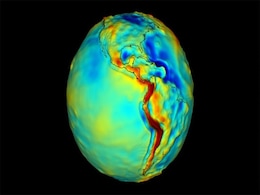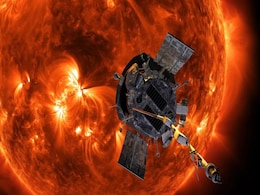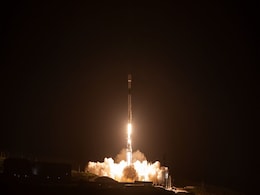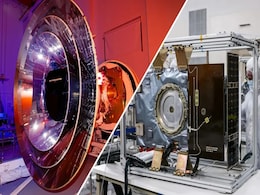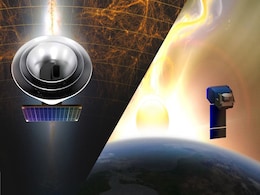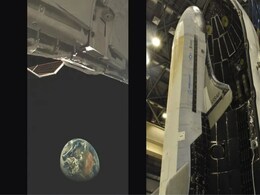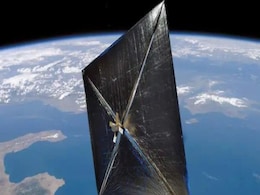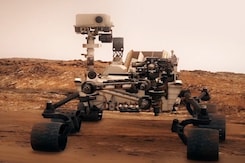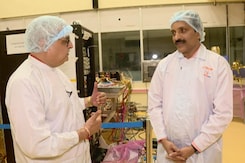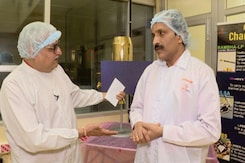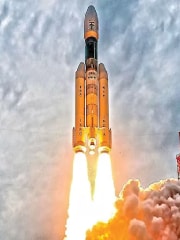Solar Mission
- All
- News
- Videos
- Web Stories
-

NASA Prepares to Launch First Quantum Sensor for Measuring Gravity from Orbit
- Friday April 18, 2025
- Written by Gadgets 360 Staff
NASA, in collaboration with academia and private companies, is developing the first quantum sensor to map Earth’s gravity from space. Using cold rubidium atoms, the compact instrument will deliver highly sensitive, long-term measurements. This mission could transform how we study Earth’s subsurface and explore planetary bodies across the solar ...
-
 www.gadgets360.com
www.gadgets360.com
-

NASA’s Parker Solar Probe Completes Second Close Flyby of the Sun at Record Speed
- Monday April 7, 2025
- Written by Gadgets 360 Staff
NASA’s Parker Solar Probe completed a close flyby of the Sun on March 22, travelling at 692,000 kilometres per hour and approaching within 6.1 million kilometres of the solar surface. The mission, designed to study solar winds and space weather, received a healthy signal back on March 25. The team, including NASA and Johns Hopkins APL experts, ha...
-
 www.gadgets360.com
www.gadgets360.com
-

Artemis II Orion Service Module Secured for Launch at Kennedy Space Center
- Saturday March 29, 2025
- Written by Gadgets 360 Staff
NASA’s Artemis II Orion spacecraft is a step closer to its mission around the Moon. Three spacecraft adapter jettison fairings have been installed on its service module at Kennedy Space Center. These panels will protect the solar arrays from heat, wind, and acoustic forces during launch. Once in space, they will detach, allowing the arrays to dep...
-
 www.gadgets360.com
www.gadgets360.com
-

NASA’s EZIE Satellites Begin Mission to Study Auroral Electrojets and Space Weather
- Friday March 21, 2025
- Written by Gadgets 360 Staff
NASA’s Electrojet Zeeman Imaging Explorer (EZIE) mission has been launched aboard a SpaceX Falcon 9 from Vandenberg Space Force Base. The trio of small satellites will map auroral electrojets, powerful currents in Earth’s atmosphere linked to solar storms. Their data will enhance space weather prediction models and help understand planetary mag...
-
 www.gadgets360.com
www.gadgets360.com
-

SpaceX Falcon 9 Successfully Deploys NASA’s SPHEREx Telescope and PUNCH Probes
- Thursday March 13, 2025
- Written by Gadgets 360 Staff
NASA’s SPHEREx and PUNCH missions have successfully launched aboard a SpaceX Falcon 9 rocket from Vandenberg Space Force Base in California. SPHEREx will map the entire celestial sky in 102 infrared colours, while PUNCH will study the transition of the sun’s corona into the solar wind. The two-year missions aim to deepen our understanding of th...
-
 www.gadgets360.com
www.gadgets360.com
-

NASA Delays SPHEREx and PUNCH Missions Due to SpaceX Vehicle Checks
- Tuesday March 11, 2025
- Written by Gadgets 360 Staff
NASA’s planned launch of the SPHEREx and PUNCH missions aboard a SpaceX Falcon 9 rocket has been postponed. Originally set for March 8 at Vandenberg Space Force Base, the launch was delayed as SpaceX conducts additional vehicle checkouts. SPHEREx will focus on mapping the universe using infrared light, while PUNCH will examine solar wind and coro...
-
 www.gadgets360.com
www.gadgets360.com
-

NASA Reschedules SPHEREx and PUNCH Missions, Now Set for March 7 Launch
- Friday March 7, 2025
- Written by Gadgets 360 Staff
NASA’s SPHEREx and PUNCH missions, originally set for February 27, have faced another delay. The launch, previously rescheduled for March 4, is now expected to take place on March 7 at 10:09 p.m. EST from Vandenberg Space Force Base, California. NASA cited scheduling constraints at the Western Range as the reason for the latest postponement. The ...
-
 www.gadgets360.com
www.gadgets360.com
-

Aditya-L1’s SUIT Telescope Captures First-Ever Solar Flare Kernel, Revealing Unseen Solar Activity
- Friday March 7, 2025
- Written by Gadgets 360 Staff
India’s Aditya-L1 mission has achieved a historic milestone with its Solar Ultra-violet Imaging Telescope (SUIT) capturing the first-ever solar flare kernel in the near-ultraviolet spectrum. This unprecedented observation confirms energy transfer across different layers of the Sun's atmosphere, advancing the understanding of solar flares and spac...
-
 www.gadgets360.com
www.gadgets360.com
-

Firefly Blue Ghost Moon Lander Successfully Lands on Moon for NASA Mission
- Wednesday March 5, 2025
- Written by Gadgets 360 Staff
Firefly Aerospace’s Blue Ghost lander has successfully landed on the Moon, marking a major milestone in private space exploration. Part of NASA’s Commercial Lunar Payload Services (CLPS) program, the mission aims to study radiation levels, test lunar sample collection, and capture a total solar eclipse. The spacecraft, which landed in Mare Cris...
-
 www.gadgets360.com
www.gadgets360.com
-

NASA’s New Missions Will Map the Sun and the Cosmos
- Tuesday March 4, 2025
- Written by Gadgets 360 Staff
NASA is set to launch two major missions, PUNCH and SPHEREx, aboard a SpaceX Falcon 9 from Vandenberg Space Force Base on March 2. PUNCH, a four-satellite system, will study the sun’s corona and space weather, while SPHEREx will create infrared maps of the cosmos to study galaxy evolution and cosmic history. These missions will contribute to a de...
-
 www.gadgets360.com
www.gadgets360.com
-

NASA Launches Satellite On Mission To Detect Water On The Moon
- Thursday February 27, 2025
- Science | Reuters
Lunar Trailblazer, which weighs about 440 pounds (200 kg) and measures about 11.5 feet (3.5 meters) wide when its solar panels are fully deployed, is being sent to find and map this water on the moon's surface.
-
 www.ndtv.com
www.ndtv.com
-

Solar System’s Journey Through Orion Complex May Have Altered Earth’s Climate
- Monday March 3, 2025
- Written by Gadgets 360 Staff
Scientists have studied the solar system’s passage through the Orion complex, a dense region in space, around 14 million years ago. According to researchers, this movement may have compressed the heliosphere and increased interstellar dust reaching Earth. This dust could have influenced the planet’s climate and left traces in geological records...
-
 www.gadgets360.com
www.gadgets360.com
-

US Space Force Shares First X-37B Space Plane Image, Revealing Mission Insights
- Tuesday February 25, 2025
- Written by Gadgets 360 Staff
The US Space Force has released the first-ever image of its X-37B space plane in orbit. Captured while conducting experiments above the African continent, the image shows the spacecraft’s solar panel and open payload bay. The X-37B, launched on December 28, 2023, has been in orbit for over a year, testing new space domain awareness technologies a...
-
 www.gadgets360.com
www.gadgets360.com
-

Solar Sail Satellites Could Enhance Space Weather Forecasting and Alerts
- Tuesday February 18, 2025
- Written by Gadgets 360 Staff
Solar sail satellites, harnessing sunlight for propulsion, are being developed to improve space weather forecasting. NOAA and NASA’s Solar Cruiser project aims to extend geomagnetic storm alert times by 50%, reducing risks to power grids, GPS, and air traffic. The new spacecraft, expected to launch in 2029, will move beyond traditional observatio...
-
 www.gadgets360.com
www.gadgets360.com
-

May 2024 Solar Storm Triggers Unusual Radiation Belts, Raising Space Safety Concerns
- Wednesday February 12, 2025
- Written by Gadgets 360 Staff
A significant solar storm in May 2024 led to the creation of two temporary radiation belts, detected by the CIRBE satellite in June. One belt contained high-energy electrons, while the other was rich in protons, a rare occurrence. While the electron belt dissipated in three months, the proton-dominated belt remains, potentially affecting space miss...
-
 www.gadgets360.com
www.gadgets360.com
-

NASA Prepares to Launch First Quantum Sensor for Measuring Gravity from Orbit
- Friday April 18, 2025
- Written by Gadgets 360 Staff
NASA, in collaboration with academia and private companies, is developing the first quantum sensor to map Earth’s gravity from space. Using cold rubidium atoms, the compact instrument will deliver highly sensitive, long-term measurements. This mission could transform how we study Earth’s subsurface and explore planetary bodies across the solar ...
-
 www.gadgets360.com
www.gadgets360.com
-

NASA’s Parker Solar Probe Completes Second Close Flyby of the Sun at Record Speed
- Monday April 7, 2025
- Written by Gadgets 360 Staff
NASA’s Parker Solar Probe completed a close flyby of the Sun on March 22, travelling at 692,000 kilometres per hour and approaching within 6.1 million kilometres of the solar surface. The mission, designed to study solar winds and space weather, received a healthy signal back on March 25. The team, including NASA and Johns Hopkins APL experts, ha...
-
 www.gadgets360.com
www.gadgets360.com
-

Artemis II Orion Service Module Secured for Launch at Kennedy Space Center
- Saturday March 29, 2025
- Written by Gadgets 360 Staff
NASA’s Artemis II Orion spacecraft is a step closer to its mission around the Moon. Three spacecraft adapter jettison fairings have been installed on its service module at Kennedy Space Center. These panels will protect the solar arrays from heat, wind, and acoustic forces during launch. Once in space, they will detach, allowing the arrays to dep...
-
 www.gadgets360.com
www.gadgets360.com
-

NASA’s EZIE Satellites Begin Mission to Study Auroral Electrojets and Space Weather
- Friday March 21, 2025
- Written by Gadgets 360 Staff
NASA’s Electrojet Zeeman Imaging Explorer (EZIE) mission has been launched aboard a SpaceX Falcon 9 from Vandenberg Space Force Base. The trio of small satellites will map auroral electrojets, powerful currents in Earth’s atmosphere linked to solar storms. Their data will enhance space weather prediction models and help understand planetary mag...
-
 www.gadgets360.com
www.gadgets360.com
-

SpaceX Falcon 9 Successfully Deploys NASA’s SPHEREx Telescope and PUNCH Probes
- Thursday March 13, 2025
- Written by Gadgets 360 Staff
NASA’s SPHEREx and PUNCH missions have successfully launched aboard a SpaceX Falcon 9 rocket from Vandenberg Space Force Base in California. SPHEREx will map the entire celestial sky in 102 infrared colours, while PUNCH will study the transition of the sun’s corona into the solar wind. The two-year missions aim to deepen our understanding of th...
-
 www.gadgets360.com
www.gadgets360.com
-

NASA Delays SPHEREx and PUNCH Missions Due to SpaceX Vehicle Checks
- Tuesday March 11, 2025
- Written by Gadgets 360 Staff
NASA’s planned launch of the SPHEREx and PUNCH missions aboard a SpaceX Falcon 9 rocket has been postponed. Originally set for March 8 at Vandenberg Space Force Base, the launch was delayed as SpaceX conducts additional vehicle checkouts. SPHEREx will focus on mapping the universe using infrared light, while PUNCH will examine solar wind and coro...
-
 www.gadgets360.com
www.gadgets360.com
-

NASA Reschedules SPHEREx and PUNCH Missions, Now Set for March 7 Launch
- Friday March 7, 2025
- Written by Gadgets 360 Staff
NASA’s SPHEREx and PUNCH missions, originally set for February 27, have faced another delay. The launch, previously rescheduled for March 4, is now expected to take place on March 7 at 10:09 p.m. EST from Vandenberg Space Force Base, California. NASA cited scheduling constraints at the Western Range as the reason for the latest postponement. The ...
-
 www.gadgets360.com
www.gadgets360.com
-

Aditya-L1’s SUIT Telescope Captures First-Ever Solar Flare Kernel, Revealing Unseen Solar Activity
- Friday March 7, 2025
- Written by Gadgets 360 Staff
India’s Aditya-L1 mission has achieved a historic milestone with its Solar Ultra-violet Imaging Telescope (SUIT) capturing the first-ever solar flare kernel in the near-ultraviolet spectrum. This unprecedented observation confirms energy transfer across different layers of the Sun's atmosphere, advancing the understanding of solar flares and spac...
-
 www.gadgets360.com
www.gadgets360.com
-

Firefly Blue Ghost Moon Lander Successfully Lands on Moon for NASA Mission
- Wednesday March 5, 2025
- Written by Gadgets 360 Staff
Firefly Aerospace’s Blue Ghost lander has successfully landed on the Moon, marking a major milestone in private space exploration. Part of NASA’s Commercial Lunar Payload Services (CLPS) program, the mission aims to study radiation levels, test lunar sample collection, and capture a total solar eclipse. The spacecraft, which landed in Mare Cris...
-
 www.gadgets360.com
www.gadgets360.com
-

NASA’s New Missions Will Map the Sun and the Cosmos
- Tuesday March 4, 2025
- Written by Gadgets 360 Staff
NASA is set to launch two major missions, PUNCH and SPHEREx, aboard a SpaceX Falcon 9 from Vandenberg Space Force Base on March 2. PUNCH, a four-satellite system, will study the sun’s corona and space weather, while SPHEREx will create infrared maps of the cosmos to study galaxy evolution and cosmic history. These missions will contribute to a de...
-
 www.gadgets360.com
www.gadgets360.com
-

NASA Launches Satellite On Mission To Detect Water On The Moon
- Thursday February 27, 2025
- Science | Reuters
Lunar Trailblazer, which weighs about 440 pounds (200 kg) and measures about 11.5 feet (3.5 meters) wide when its solar panels are fully deployed, is being sent to find and map this water on the moon's surface.
-
 www.ndtv.com
www.ndtv.com
-

Solar System’s Journey Through Orion Complex May Have Altered Earth’s Climate
- Monday March 3, 2025
- Written by Gadgets 360 Staff
Scientists have studied the solar system’s passage through the Orion complex, a dense region in space, around 14 million years ago. According to researchers, this movement may have compressed the heliosphere and increased interstellar dust reaching Earth. This dust could have influenced the planet’s climate and left traces in geological records...
-
 www.gadgets360.com
www.gadgets360.com
-

US Space Force Shares First X-37B Space Plane Image, Revealing Mission Insights
- Tuesday February 25, 2025
- Written by Gadgets 360 Staff
The US Space Force has released the first-ever image of its X-37B space plane in orbit. Captured while conducting experiments above the African continent, the image shows the spacecraft’s solar panel and open payload bay. The X-37B, launched on December 28, 2023, has been in orbit for over a year, testing new space domain awareness technologies a...
-
 www.gadgets360.com
www.gadgets360.com
-

Solar Sail Satellites Could Enhance Space Weather Forecasting and Alerts
- Tuesday February 18, 2025
- Written by Gadgets 360 Staff
Solar sail satellites, harnessing sunlight for propulsion, are being developed to improve space weather forecasting. NOAA and NASA’s Solar Cruiser project aims to extend geomagnetic storm alert times by 50%, reducing risks to power grids, GPS, and air traffic. The new spacecraft, expected to launch in 2029, will move beyond traditional observatio...
-
 www.gadgets360.com
www.gadgets360.com
-

May 2024 Solar Storm Triggers Unusual Radiation Belts, Raising Space Safety Concerns
- Wednesday February 12, 2025
- Written by Gadgets 360 Staff
A significant solar storm in May 2024 led to the creation of two temporary radiation belts, detected by the CIRBE satellite in June. One belt contained high-energy electrons, while the other was rich in protons, a rare occurrence. While the electron belt dissipated in three months, the proton-dominated belt remains, potentially affecting space miss...
-
 www.gadgets360.com
www.gadgets360.com

